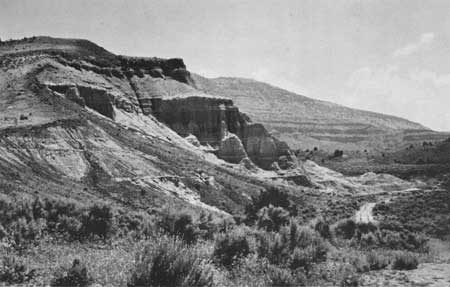|
JOHN DAY FOSSIL BEDS
John Day Fossil Beds: A Study (Preliminary) |

|
THE RESOURCES
NATURAL HISTORY
The John Day Fossil Bed Formation is colorful and rugged. The most widely known of these fossil-bearing beds, with their attendant scenic features, are essentially contained within eight existing State park units. Five of these are along the John Day River and State Highway 19 between the town of Kimberly and Picture Gorge, and a sixth unit is west of Dayville; all are in Grant County. Two units are in Wheeler County: one between the communities of Fossil and Clarno on State Highway 218; the other, ten miles northwest of Mitchell on a local route known as the Bridge Creek Road.
Other areas of particular interest, such as Haystack Valley and Clarno Vertebrate Quarry are of paleontological importance but are not currently included in the State park system. Units of scenic value are:
Sheep Rock (3,965 acres) This colorful and spectacular park takes its name from a prominent and sharply pyramidical peak with an elevation of 3,566 feet and rising 1,337 feet above the valley floor. The peak is readily identified by its dark "cap sheaf" of Columbia River Basalt resting on top of the John Day Formation, which makes up the mountain mass. This basalt remnant has the appearance of being ready to fall from the peak top at any time. The geologic deposits forming the mountain mass are highly picturesque with their many bands of delicate tints and shades of changing color. Also within this unit is the interesting "Painted Gorge" which takes its name from the many Indian pictographs found on the smooth rock faces of the canyon wall. Their location within a few feet of the highway has made protection difficult and they have been rather severely defaced. The dark coloring of the gorge contrasts with the light shade of the surrounding area.
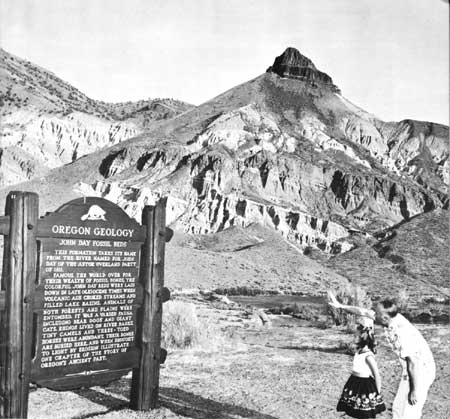
Sheep Rock, Thomas Condon-John Day Fossil Beds State Park. A major landmark of the John Day Fossil Basin and the key interpretive site. Photo courtesy of Travel Division, Oregon State Highway Department Turtle Cove (240 acres) This unit is considered by scientists as the "largest exposure" of the John Day Formations in the area and takes its name from the fossil remains of land turtles and tortoises found here. The University of California party of 1899 referred to the area as "Blue Basin" because of its color and was described by them as a veritable labyrinth of canyons, gulches, and coves cut into the soft blue rock of the middle John Day Formation by heavy rains. The coloring of these beds is outstanding; all of the most delicate shades are prevalent.
The Foree Unit (80 acres) a few miles north on State Highway 19 contains similar scenic and scientific features.

Foree Unit, Thomas Condon-John Day Fossil Beds State Park. ABOVE: View of banded, colorful exposures of John Day Formation. BELOW: Detail view at same Formation. The Cathedral (40 acres) This site presents one of the most impressive and striking views of the middle John Day Formation. Adjacent to the highway, it offers the traveler a close-up view of this fossiliferous division with its fluted columns of delicately tinted shades of blue and green.
William Mascall Overlook (2 acres) This site not only includes a comprehensive view of the Sheep Rock-Picture Gorge Unit but also the Cottonwood Creek Valley where the Mascall Formation rests upon the Columbia lava which overlies the John Day beds. An excellent view of the picturesque Mascall, Rattlesnake, and John Day Formations can be observed from this point.
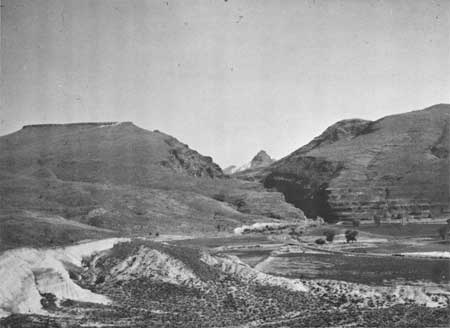
View north from Mascall Overlook. Three of the four geologic ages of the Tertiary Period as represented in the Upper John Day Basin are visible from this point. Picture Gorge, with the cap of Sheep Rock immediately behind it, is at the right center. The Mascall Formation is in the foreground. Davis Dike (20 acres) Here the traveler receives an impressive close-up view of the Columbia lava formation. At this site a lengthy, intrusive, basaltic dike crosses both State Highway 19 and the John Day River, a remnant of which rises some 10 to 12 feet above the river bank and is also discernible for some distance up the mountain slope east of the highway.
Clarno State Park (120 acres) This unit, while not as colorful as the others in the State park complex, is quite picturesque. Much of this formation is varicolored brecias, conglomerate tuffs, and rhyolite flows which have been eroded into peculiar shapes. It is a concentration of massive fluted columns. Its location adjacent to a highway, State Route 218, offers the traveler a close view of this colorful and outstanding example of the Clarno Formation.
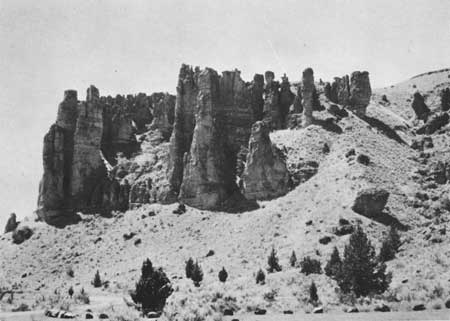
Colorful, eroded spires in Clarno State Park. Painted Hills State Park (13.2 acres in fee plus public use easement on 2,830 acres) This significant name so adequately describes the surface of this park unit that it almost overshadows its scientific importance. Two basic formations are exposed here—the Upper Clarno and lower John Day. The valley floor or the Clarno Formation is usually a grey or buff, but sometimes shows brilliant colorations of red, green and brown. Above the valley floor the rising center of the John Day Formations display their bright harmoniously-blended colorings on smoothly rounded domes, slopes, and ridges of varying heights. The State is negotiating for the purchase of the 2,830 acres of privately owned land.
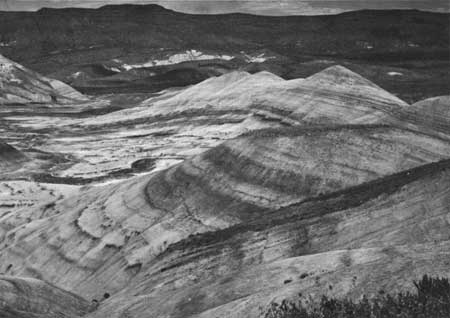
Painted Hills State Park.
GEOLOGY
The upper basin of the John Day River Drainage extends from the gorge at Clarno, near Clarno State Park, through all of the upstream drainage. The river, called the Middle Fork, has two branches: the North Fork and the South Fork. Numerous tributary creeks feed the river along its course. Elevation varies from approximately 2,500 feet at Clarno to 9,000 feet in the Strawberry Mountains, The regional climate is now semi-arid, but in the geologic past it ranged all the way to subtropical at the beginning of the Cenozoic era. Prior to this time most of the State was covered by the oceans. There is very little evidence of the invasion of the seas in the basin area where the older deposits are buried under the more recent Cenozoic rock which has not yet eroded away.
During the Cenozoic era, formations containing fossils were laid down. It represents earth history of the last 70 million years and is divided into two periods, of which Quaternary is the most recent 2 or 3 million years. This period in turn is divided into two epochs: the Recent includes current time to 1 million years ago; and the Pleistocene, from 1 to 3 million years ago. The previous period is Tertiary, which goes back 70 million years and is divided into five epochs: Pliocene, Miocene, Oligocene, Eocene, and Paleocene (listed in order of the youngest first). All but the Paleocene are recorded in the Upper John Day Basin.
Of the formations seen in the John Day Basin the oldest is called the Clarno. This extensive formation has outcrops beyond the basin area and is calculated to be 37 million years old. The formation consists of basaltic and rhyolitic flows, breccia, tuff, volcanic conglomerate, and some thin lenses of water-laid volcanic ash. Fossil plants and animals from the Clarno indicate an age of late Eocene and early Oligocene.
The John Day Formation, above the Clarno, was deposited after the Clarno was deformed. It, too, extends considerably beyond the basin. The upper formation is buff, the middle is green, and the lower is red tuffaceous siltstone. Much of the formation originated as volcanic ash. Fossil plants in the lower section confirm the late Oligocene age and the mammal remains in the upper section indicate the early Miocene age.
Overlying the John Day is the Columbia River Basalt (from the Miocene epoch), much of which has been removed by erosion, This lava was from great long narrow splits in the ground that spread the flow over extensive land areas. Repeated flows over millions of years built up great thicknesses of basalt. Davis Dike, among others, illustrates the source of the tremendous quantity of lava which covered northeast Oregon to a depth of 2,500 feet in places. These are not like volcanic flows that commonly eject from a single vent in a built-up mountain with secondary flows from fissures in the mountain side.
The next younger formation is the Mascall, directly on top of the Columbia. Present exposures are mostly in the John Day Basin where an exposure of 2,100 feet is in evidence. The formation is water-laid light-colored tuffaceous volcanic ash. Fossil remains indicate the Miocene age, approximately 15 million years old.
The 6.5 million year old Rattlesnake Formation on top of the Mascall is from the Pliocene epoch, the youngest of the Tertiary Period. It consists of bedded-tuffs, gravels, and sandstone of lacustruce and fluviatile origin, contains many fossils, and was dated by the potassium-argon method.
Erosion during the more recent Pleistocene epoch formed many terraces, talus slopes, and alluvial deposits. These deposits are the source of gold which figured so prominently in the initial settlement of this area.
JOHN DAY BASIN GEOLOGY
| PERIOD | EPOCH | FORMATION | GEOLOGIC EVENTS |
| QUATERNARY | RECENT | ALLUVIUM | GLACIERS RECEDING. PRESENTLY EXISTING VOLCANOES FORMED. SOME LAVA FLOWS. |
| PLEISTOCENE (1-m yrs) |
FLOWS AND CINDERS | LARGE GLACIERS IN THE MOUNTAINS. LARGE LAKES IN SOUTH-CENTRAL OREGON. MASTADON AND GIANT BEAVER IN THE CASCADES. HORSE AND CAMEL IN THE FOSSIL LAKE AREA. | |
| CENOZOIC ERA TERTIARY |
PLIOCENE (13-m yrs) |
RATTLESNAKE (6.4-m yrs) |
FIRST VOLCANOES IN CASCADES. MANY LAVA FLOWS IN SOUTH-CENTRAL OREGON. HORSES, RHINOS, CAMELS, ANTELOPE, BEAR, AND MASTADON IN JOHN DAY AREA. WARM TEMPERATE CLIMATE. |
| MIOCENE (25-m yrs) |
MASCALL (15-m yrs) COLUMBIA RIVER BASALT (18-m yrs) |
LAVA FLOWS OVER MUCH OF THE STATE. OREDONTS, THREE-TOED HORSES, GIANT PIGS, AND SABER-TOOTHED CATS IN THE JOHN DAY AREA. MILD HUMID CLIMATE IN EASTERN OREGON. | |
| OLIGOCENE (36-m yrs) |
JOHN DAY (25-m yrs) |
WARM TEMPERATURE FLORA THROUGHOUT THE STATE. THREE-TOURED HORSES, CAMELS, GIANT PIGS, SABER-TOOTHED CATS, OREDONTS, AND TAPIR IN JOHN DAY AREA. CASCADE RANGE LOW, NO EFFECT ON CLIMATE. | |
| EOCENE (63-m yrs) |
CLARNO (37-m yrs) |
SUB-TROPICAL FORESTS IN CENTRAL OREGON. PALMS, FIGS, AVOCADOS, PECAN, AND WALNUT. FOUR-TOURED HORSES, RHINOS, TAPIR, AND CROCODILE IN CLARNO AREA. VOLCANOES IN THE CASCADES AND SEA INVASION OF EASTERN OREGON. |
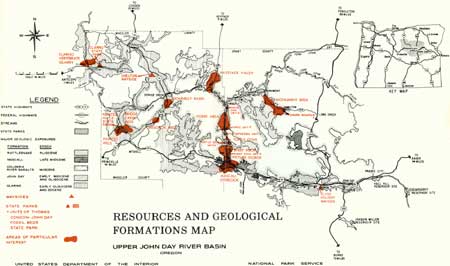
|
| Resources and Geological Formations Map. (click on image for an enlargement in a new window) |
Fossils
John Day Basin is primarily significant as a record of the earth's history displayed through rocks and fossils which cover a considerable period of time.
Pre-Tertiary: Although the most complete record of life is in the Tertiary rocks, this is not the beginning of the local record. Pre-Tertiary rocks more than 100 million years old are also present in the John Day Basin. The record indicates the presence of a sea in the area at this early date; ammonites, shore shells, and bones of swimming and gliding reptiles are present. Because it is overlain by a tremendous volume of younger rocks, this very early record is poorly represented in the basin.
Clarno Formation: The Clarno flora and fauna are the oldest Tertiary life in the basin. The flora fossils found here are sub-tropical; the laurel and palm families are well represented, Important fauna remains uncovered included crocodiles, amphibious and small running rhinoceros, brontotheres, tapirs and tiny horses, and peccaries and oreodonts—the pig-like artiodactyls.
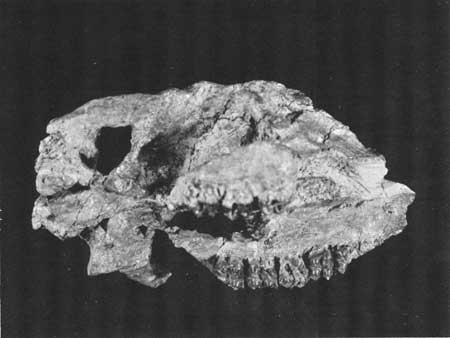
|
| Tiny horse of the Clarno Formation—about the size of a large dog; note the crushed skull. |
John Day Formation: The character of the vegetation and fauna recorded in fossils of this formation changed remarkably from that found in the Clarno. The flora look more familiar to most Americans because of their temperate character, although some of the plants have relatives living only in Asia. Oaks, elms, sycamore, chestnut, basswood, birch, horn-bean, and maples are representative of plants found in the United States today; Metasequoia and Katsura of Asia are, however, important parts of the flora. One hundred and twenty species of fossil mammals have been identified from this formation. They vary from small relatives of the opossum through sabertooth cats, rhinoceros, oreodonts, horses, peccaries and giant hogs to beavers, dogs, rabbits, and pocket mice. Tortoises, lizards, snakes, and land snails also are commonly presented in the collection.

|
| Leaves of the John Day flora, including dawn redwood, alder, birch, and Katsura tree. |
Mascall Formation: This formation reveals other life changes, especially in the recorded flora. Common plants are swamp cypress, black oak, hickory, sycamore, a small leaf maple, gingko, box elder, elm, and over sixty other less common species of plants. They represent several kinds of local habitats, reflecting hillsides, ponds, stream borders and plains. Much of the fauna was derived from earlier animal life of the John Day Formation. Three-toed horses, elk-like Dromomeryx with horns rather than antlers, bear, and mastodons appear for the first time.
Rattlesnake Formation: The flora and fauna of this formation provide the last view of Tertiary life in the John Day Basin. Dryer climate had reduced vegetation to trees and shrubs along the stream courses, and at the higher elevations grassland had become extensive. The large single toed horse and antelope had invaded the area from the south; rhinoceros, camels, peccaries, and mastodonts were common large mammals. The small sloths from South America appeared for the first time in the basin. The oreodonts so abundant in earlier fauna were no longer present and the elk-like Dromomeryx were also gone.
History of Research and Fossil Collecting
During 1861 Thomas Condon, a minister, moved to The Dalles, Oregon to establish a pioneer church. In traveling this vicinity he found fossils in some of the formations near The Dalles. Occasionally he would give brief lectures about the fossils and was recognized as a local authority on the subject. By 1864 people were bringing specimens from greater distances and Condon's collection increased in size. By 1871 Condon knew enough about the area that he published, in the Overland Monthly, an article describing the geologic history of the area. Condon later became a member of the staff of the University of Oregon.
In 1873 Le Conte, from the University of California, surveyed the basin and collected samples for study at the university.
The best known collector to visit the area and take samples for study was J. C. Merriam who made his first trip in 1899 while still at the University of California. He made numerous subsequent trips while still at California and later at Carnegie Institute. He also spent a short time at the University of Oregon where he continued his studies of the John Day area.
R. W. Chaney collected and studied in the area over a 40-year time span, starting with the Clarno Formation flora and later studying the John Day Formation.
J. A. Shotwell, University of Oregon, in more recent years worked in an area west of the present Clarno State Park. This area produced fauna fossils of the Clarno Formation which had not been previously uncovered.
During the approximately 100 years of fossil collecting and research in this area, more than 120 fossil mammal have been identified. They range in size from very small mice to huge rhinoceros and oreodonts. Fossil snails have also been collected.
HISTORY
The principal historical theme represented in the study area is that of Westward Expansion to the Pacific, 1830-1898. The more important sub-themes that relate to the history and development of the area are The Mining Frontier; Transportation and Communication; Military and Indian Affairs; Religious Movements; The Cattlemen's Empire; and The Fur Trade.
Of these subthemes, The Mining Frontier, in the form of gold mining, was the most important and dramatic. It had far-reaching consequences in the occupancy and settlement of the John Day country.
This era began in 1862 with the discovery of gold on Canyon Creek, just south of the present community of John Day. Prospectors flocked to the John Day country and to Canyon City on Canyon Creek from "diggings" in south-western Oregon and northern California. A large influx of Chinese prospectors and laborers helped shape the new "boom" town of Canyon City and the surrounding area. Canyon City was the earliest settled community in Grant County and became the county seat in 1864.
The Dalles-Canyon City pack train and stage line began operation in May, 1864. Gold was shipped on this line from Canyon City to The Dalles on the Columbia River. From there it was transported by boat down the Columbia to Astoria, thence by sea to the San Francisco mint.
In February 1867, The Dales-Canyon City Military Wagon Road was established under contract with the Army and gold shipments were continued via the Wagon Road. Some $26 million in gold was mined and shipped from Canyon City from 1862 to 1870. At its zenith, Canyon City supported a population of 10,000. However, after a few years the mines and gold-bearing gravels were worked out and the gold rush was over. All but a fraction of the Canyon City population moved to newer fields. While Canyon City today remains the county seat of Grant County, it is thoroughly modernized. Only a few individual buildings from the mining era remain.
The extraction of gold from the vicinity has continued on a limited scale until recently. One of the few gold dredges remaining in the United States and one of two in Oregon is located at Mount Vernon. It was in operation at least as recently as 1946 and is essentially intact.
The Mining Frontier, as well as the Transportation and Communication sub-themes, are represented by the site of the Burnt Ranch and stage station on the south bank of the John Day River near the mouth of Bridge Creek in western Wheeler County. The ranch and station, established in 1864, were operated by James N. Clark, an early homesteader. It was a stopping point for pack trains between Canyon City and The Dalles, and later served as a stage station. The station and ranch buildings were burned by Indians in 1866, from which the name Burnt Ranch is derived.
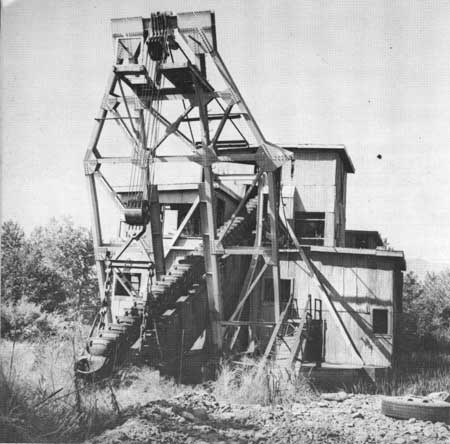
|
| Gold mining dredge at Mount Vernon. Used as recently as 1946, it is nearly intact and could be of interest to tourists. |
A ranch at Fossil is of historic interest and relates to Transportation of Communication. Four land claims were laid out here in the early 1800's. Hoover's cabin, situated on one of the claims, became the post office in 1876.
Military and Indian Affairs in the study area includes the sites of two U.S. Army posts: Camp Watson in southeastern Wheeler County and Camp Logan in southeastern Grant County. Both were short-lived. Camp Watson, astride The Dalles-Canyon City Military Wagon Road, was commissioned in 1864 to protect the gold shipments and the settlers. It was typical of the posts established along travel routes after eastern Oregon had been opened to settlement. The post was released and the buildings burned by the Army in 1869.
Camp Logan was established in 1865 and terminated in 1868. No physical evidence of either post remains today and the site of Camp Watson is not accessible by road.
A cabin built in 1864 and occupied for a time by Joaquin Miller, the "poet of the Sierras," is located in Canyon City on grounds administered by the Grant County Historical Society Museum. Miller had come to Canyon City to practice law and is said to have started writing verse here. The cabin has been moved to its present site from its original location. Miller's home in Oakland, California is a Registered National Historic Landmark.

|
| The Joaquin Miller Cabin Canyon City |
The Historical Society Museum displays an extensive collection of items from the gold mining era, plus a large assortment of antiques and relics from the frontier days to the recent past.
The first church in Grant County was the St. Thomas Episcopal Church in Canyon City. It was built in 1876 under the direction of a pioneer missionary, Dr. Rueben Denton Nevins, when Canyon City was a mining community. It is still an active church and the best remaining example of the Religious Movements sub-theme in the area.
The first cattle ranch in the general area was established northeast of John Day by the Trowbridge Company in 1862. It is still operated by the descendants of the founder and, under a program administered jointly by the Oregon Department of Agriculture and the Historical Society, it has been designated a Century Farm. Other ranches that have been in continuous operation by the same family for approximately 100 years are the Cant Ranch at the main unit of the Thomas Condon-John Day Fossil Beds State Park and the Mascall Ranch just south and east of Picture Gorge.
One other building of historical interest is the Chinese Building, located in John Day City Park. It was constructed in 1867 of masonry and hand-split logs by Chinese during the gold rush and is the only remaining structure erected by this once-numerous segment of the local population.
With respect to The Fur Trade, the area was one of the fields of operation of Hudson's Bay Company fur brigades during the 1820's and 1830's.
ARCHEOLOGY
The University of Oregon Museum of Natural History has conducted most archeological research, investigation, and cataloguing in the study area. Sites for further investigation and excavation have been found and two excavations have been made at sites adjacent to the study area. Of minor importance, they revealed only one burial, dated at about 1400 A.D., and minor artifacts. In the study area there are no known scientific excavations. One excavation was done near Service Creek but there is no record of the findings. Cave sites along Rock Creek have been vandalized by "pot-hunters," but open sites are relatively untouched. All sites investigated are only of local significance.
RECREATION
The John Day River Valley itself has very limited recreational facilities at the present time, not because of any lack of resources but because little development has as yet been accomplished.
Oregon's State Park System is widely known throughout the United States for its outstandingly high quality of development, administration, and park acquisition programs. As with other public land managing agencies, however, the mounting recreation pressures and greater demands of the more populous and heavily-travelled sections of the State have made it necessary for the State Parks and Recreation Division to concentrate its efforts and funds in those sections. Consequently, programs in areas like the upper John Day Basin have had to be deferred. Even so, some new acquisitions and developments of State Park and Recreation areas have been made, such as Clarno State Park, now in the initial phase of development, and the Clyde Holliday Wayside.
The older Shelton Wayside (180 acres) on State Highway 19, 10 miles southeast of the town of Fossil, includes a 20-unit campground. At Unity Reservoir, just east of the upstream limits of the Basin on U.S. 26, there are 20 trailer sites and minor camping facilities. Limited picnicking is available at the Foree Unit of the fossil beds area and at Painted Hills. Rest and lunch stop areas are located in a number of places along the highways: at the Johnny Kirk Springs, a highwayside a few miles north of the Sheep Rock Unit on State Route 19 noted for its abundance of cold, sparkling spring water; and the newly developed Clyde Holliday Wayside just east of Mount Vernon.
Overlook parking areas and foot trails have been established in some of the fossil bed units but, for the reasons noted above, the State has not developed an interpretive program for the scientific resources.
The Bureau of Land Management has a checkerboard pattern of public domain lands adjoining the river and has classified this land for recreational use. However, no planning or development of recreational facilities has as yet been undertaken.
The river valley offers the visitor opportunity for such recreation activities as sightseeing, steelhead and salmon fishing, picnicking, hiking, and rock and fossil hunting. With the exception of camping, for which the valley has but extremely limited potential, a definite need exists for the development of additional public use facilities and access and for the interpretation of the resources where appropriate.
The valley is surrounded almost entirely by national forests, four of which are in the basin. These lands certainly contain unlimited recreational resources. The area is widely known for its hunting of both big game and game birds. It contains the headwaters of several small rivers and many streams, which are fairly evenly distributed throughout the national forest land and maintain a year-round flow of water which supports fish life. The many small lakes are open to sport fishing throughout the year. Boating is permitted on a few of the larger lakes. Road access to the vast area is good and current camping and picnicking facilities adequate. The Malheur Forest alone has 17 improved campgrounds of various sizes, well located with good distribution throughout the forest. In addition, they have numerous unimproved areas where camping is permitted. The other forests involved have similar facilities. These are hiking and horseback riding opportunities throughout this area on an adequate system of foot and riding trails. Currently there is some winter sports activity in the forests; however, the U.S. Forest Service believes that these areas are poorly located and, consequently, during years of light snow and extremely cold temperatures, little use is made of these facilities. Because of the distance to these areas from any population center this activity would probably be limited to local use only.
In summary, interesting and colorful scenery is to be found through the entire basin and recreational resources are abundant throughout the area. The existing facilities in the John Day River Valley are not adequate, and there is a definite need to develop and interpret the resources found here. Existing facilities in the national forests, on the other hand, are more than adequate to meet the present demand. Expansion is planned by the Forest Service to accommodate public use of the national forests when the visitor use indicates the need.
It is believed that the existing, primarily natural, water resources of the Upper John Day Basin are adequate to meet the present recreational need. Should future needs require expansion, the construction of the Hall Hill, Deardorff, or Joaquin Miller Reservoirs, now under study by the Bureau of Reclamation, could well meet the demand, All are a considerable distance from the fossil beds area and the impoundments would have little or no effect on the natural qualities or features of that area.
| <<< Previous | <<< Contents>>> | Next >>> |
study/sec2.htm
Last Updated: 07-May-2007
